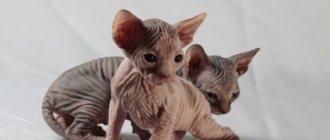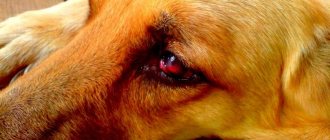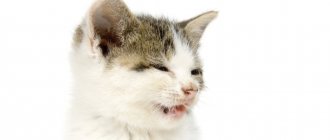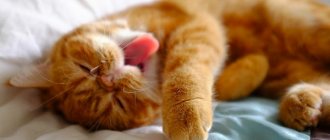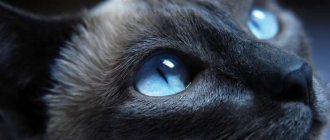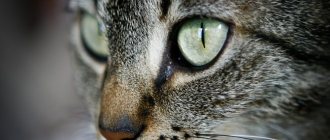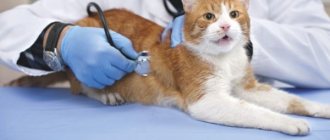Why do cats have watery eyes, main diseases.
In what situations do British eyes need to be treated:
- Inflammation as a result of injury, dust or insects getting into the eye;
- Conjunctivitis has developed;
- Prolapse of the third eyelid;
- Epiphora.
It is important to correctly determine the cause of eye inflammation; you should look at the discharge:
- Discharge yellowish, brown, thick, pus – infectious, bacterial or fungal disease;
- Watery, transparent, pet rubs | scratches eyes with paws - allergies, injury;
- Crusts, transparent, dried - dust or dirt has gotten into your eyes.
Conjunctivitis.
Infectious diseases, helminthic infestation, allergic reactions are the main causes of inflammation of the conjunctival sac.
Contagious diseases.
Lacrimation is a symptom of the following diseases: toxoplasmosis, chlamydia, calcivirosis, rhinotracheitis, panleukopenia. Both British breed cats and animals of other breeds are susceptible to this disease.
If left untreated, conjunctivitis becomes purulent, which will lead to the development of uveitis and may result in blindness.
Elimination of inflammation - treatment of the underlying disease.
Worm infestation.
Nematodes that live in the intestines produce waste products that have allergenic properties. As a result, the cat develops lacrimation and other pathological symptoms.
Elimination of conjunctivitis - deworming the cat with an anthelmintic; it is better to use 3 in 1 products - against fleas, ticks, and worms.
Allergic reaction.
The British, like other artificially bred breeds, are susceptible to allergies. The British breed also has a special skull structure.
Irritants that cause lacrimation:
- Cigarette smoke, dust, perfume, eau de toilette, air fresheners;
- Feed | food allergens. Poor quality feed causes hypersensitivity. Natural feeding often causes skin rashes and it is difficult to determine the source of the allergen.
Read more about foodborne dermatoses here.
Treatment - eliminate the inhaled irritant, find out the cause of the allergic response, use antimicrobial eye drops:
- “Diamond Eyes” - contains chlorhexidine;
- “Iris” contains gentamicin.
Prolapse of the third eyelid.
Blinking membrane disease | third century. Forms in which inflammation can occur: abnormal development of supporting cartilage, protrusion | prolapse, adenoma. If both eyes are affected, it is a contagious disease.
Antiphlogistic drops and ointments are used for unilateral inflammation. The effect is not achieved - they operate surgically.
Epiphora.
Epiphora is characterized by copious continuous discharge and very watery eyes. Britons experience blocked tear ducts or inflamed eyelids | blepharitis due to the special structure of the lacrimal canal.
Treatment - wash the eyes and place tetracycline ointment in the conjunctival sac for 5-7 days. The treatment did not help - they operated on him.
This is interesting: The cost of a British kitten
Eye injuries
Sometimes cat owners try to dig deep in an attempt to find out the cause of the problem, but it lies on the surface. The cat simply injured his eye or something got in there. Take a closer look, preferably in good daylight. Do you see any problems on the cornea? If you see that some foreign object (lint, wool, soil) is in the eye, under no circumstances start picking it out with your finger or cotton wool: you can seriously injure the eye. Moreover, Scottish cats have bulging eyes - it is very easy to cause injury. It’s better to rinse your eyes so that the lint comes out on its own.
How to wash the eyes of a Scottish kitten or a cat of any other breed? To do this, prepare lukewarm purified or boiled water or a decoction of chamomile, sage, calendula, St. John's wort, tea. Pour the liquid into a small container and throw in a few cotton pads (never an ordinary cotton pad, otherwise you risk giving your eye new lint). Before wetting, pat the discs so that there is no lint on them. Next, lay or sit the cat so that its eyes are turned upward. It is advisable to do this together: one holds, the other rinses. The task of the one who holds is to make sure that the cat does not twitch and that his eyes are turned upward. The task of the person who is dripping is to very carefully part the eyelids (not too much), take a slightly squeezed cotton pad and squeeze the liquid into the eye. If you have a clean dropper in the house, it is better to use it. After instillation, the cat will reflexively close its eyes, let him do this. The main thing is that the liquid gets into the eye initially. Repeat the procedure 2-3 times until the desired effect is achieved.
If there is some kind of hard foreign object in the cat’s eyes that you can’t just wash off, then this is a reason to urgently seek help from a veterinarian.
Prevention measures
Cats are incredibly clean and can take care of their eyes on their own. They wash themselves regularly, putting themselves in order, but they are not able to cope with the disease. Owners of four-legged furry dogs should check them regularly. Particular attention is paid to animals that walk outside. To prevent pathology it is necessary:
- Feed your pet high-quality food. Balance your diet and don’t experiment with it.
- Visit the veterinarian, get vaccinations and examination of internal organs.
- Ensure your pet has an active lifestyle, play with him, and go out into the fresh air.
- Protect from contact with sick and unfamiliar animals.
- Regularly cleanse the body of helminths.
- Monitor the length of the claws and trim them in time so that the pet does not injure itself.
Owners of purebred cats prone to excessive tearing should make it a rule to treat their eyes daily. With increased tear production associated with the characteristics of the breed, you may not immediately notice that the animal has health problems. Monitor the nature of the discharge and pay attention to your pet’s behavior.
Simple prevention methods will help protect your cat from various troubles, including eye problems. If you have the slightest doubt about the causes of tearing, contact your veterinary clinic. Remember that home remedies are temporary measures to combat the problem. Only a doctor can rid an animal of the causes of unpleasant discharge.
This article will tell you what to do when a Scottish kitten has watery eyes. In addition, we will identify the reasons why the eyes become watery and tell you how to distinguish whether a kitten’s eyes are watery or festering.
Preventive measures
In order for an animal not to get sick, it must eat properly. Cat nutrition is the key to their health and longevity. You should not feed your pets from your own table. You should initially accustom your four-legged friend to a certain diet. It should be remembered that food should be without salt and spices.
It is very important to keep the room clean and tidy. Sometimes tearfulness in animals appears as a reaction to dust. To prevent this from happening in the future, you need to do wet cleaning once a week.
The British cannot tolerate drafts or smoke, so it is better not to smoke in a room where there is an animal. Clear eyes indicate the health of the animal, while their cloudiness, as well as tears, indicate some kind of problem. When using eye drops, they should be applied in small quantities to check for an allergic reaction. Only after this can therapy begin.
Author of the article Tatyana Kopsheva Doctor of Veterinary Medicine 99 articles written
Additional symptoms
If the problem is not related to allergies, then the pet may have noticeable redness of the conjunctiva.
When a British cat's eyes become watery due to the influence of an allergen or irritant, no additional symptoms may be recorded. In this case, no special treatment is required and the problem goes away on its own after the irritant is eliminated. When pathological factors become the source of increased tearing, the Briton may develop a fever and experience other clinical signs:
- swelling in the area of the visual organs;
- purulent or mucous discharge;
- brown or red crust in the corner of the eye;
- itchy sensations;
- swelling of the conjunctival membrane and its redness;
- fear of bright light.
With prolonged tearing, Britons often experience hair loss around the eyes, which soon leads to sores and dermatitis.
What can be done?
Here are some methods that you can resort to in case of such a problem:
If your British cat suffers from conjunctivitis or she has suffered an eye injury, which is why she has purulent discharge, then purchase Phytoelite-Chamomile. When your four-legged friend suffers from a viral, microbial or infectious disease, then it is worth using “Phytoelite-St. John’s wort”. If you know for sure that your animal may have tearing due to an allergic reaction, then buy “Phytoelite-calendula” for it.
Grown-up individuals
After 6 months of age, any discharge from the animal’s eyes should stop. If the problem does not disappear, it is worth monitoring the pet’s behavior. If a Briton’s eyes are watery for several days, the cat scratches them and squints, we can assume different versions:
- hit by a speck;
- blockage of the tear ducts (the eyes begin to sour);
- mucosal injury;
- allergies to various pathogens;
- helminthic infestations;
- infections – dangerous and not so dangerous.
Before proceeding with treatment of the pathology, the cause of lacrimation should be established.
Infectious and other diseases
Most often, cats are exposed to conjunctivitis; the disease develops gradually, but with complications it also affects other organs except the visual ones. Treatment begins with washing the eyes with a cleansing solution and contacting a specialist. The doctor will prescribe the most effective drug, and you can rid your animal of the disease at home. Antibiotic containing drugs are prescribed:
- sofradex;
- Tevomycetin;
- tetracycline.
For additional therapy, drops containing silver are used, such as Cliny Eye Cleansing Lotion. Treatment should include both eyes, even if one is healthy. Self-medication with such a diagnosis can worsen the animal’s condition. The disease has different pathogens, depending on which drugs are selected.
- Prazitel;
- Drontal;
- Celandine;
- Pratel;
- Dirofen;
- Vacation.
The specialist may prescribe other medications. When you get rid of the main cause of lacrimation and other ailments, the symptoms themselves disappear. During the treatment period, your pet's eyes require careful attention, regular washing and disinfection.
Symptoms
If a pathological cause is obvious, all manifestations of the disease should be observed to give the doctor as complete a history as possible to ensure the best decision.
Common cat diseases manifest themselves as follows:
| Symptom | Disease and cause |
| Long and profuse tearing. | Viruses and fungi such as plasmosis: calcivirosis, mycoplasmosis, toxoplasmosis, etc. |
| Pus. | Foreign objects. |
| Edema. | Turn of the century. |
| Cloudiness. | Keratitis, cataract. |
| Black spot. | Dying of the cornea. |
| Tears are accompanied by fever, diarrhea, vomiting, and lethargy. | Feline distemper (panleukopenia). |
| Swelling with cloudiness. | Glaucoma. |
| Swelling in the corners of the eye. | Inflammation of the lacrimal glands. |
| Redness of the membranes, photophobia. | Conjunctivitis. |
| Damage to one eye. | Parasites. |
This is interesting: When to castrate a British cat
What to do and how to deal with the problem?
“Diamond Eyes” drops will put the animal’s visual apparatus in order.
If your Briton's eyes start to water, you can help your pet at home. Antiparasitic drugs are purchased from a veterinary pharmacy and given to the animal. In this case, it is recommended to prepare a chamomile-based decoction or strongly brew black tea and wipe the Briton’s sore eyes several times a day so that they stop watering. The procedure is performed with clean hands, using a separate cotton pad for each visual organ. If home methods do not help eliminate excessive tearing in cats of the British breed, then contact a veterinarian who will conduct an examination and prescribe drug therapy. The following veterinary drugs help with violations:
- "Iris";
- "Diamond Eyes";
- herbal lotion “Fitoelite”.
You should not give pets medications at your own discretion, since many of them have contraindications and can lead to complications. To combat increased tearfulness, tetracycline ointment is used, which is placed under the eyelid. Furacilin solution and potassium permanganate diluted in water are also useful. British people wash their eyes with these products several times a day. To prevent watery eyes in British cats, you should monitor their diet and avoid allergic reactions and parasites.
Medicines
You can treat a kitten with folk remedies, but they are not always effective. Therefore, if you have not noticed a visible effect after a course of rinsing, try some proven medications.
- At night, tetracycline ointment is placed behind the kittens' eyelids.
- Lightly dissolve potassium permanganate or furatsilin in water and use for rinsing.
- The product "Iris" contains chloramphenicol, so it perfectly fights irritation and allergies.
- “Diamond Eyes” is an excellent remedy for treating watery eyes in a kitten based on taurine and succinic acid. Helps combat mucous membrane irritation in animals.
- If your cat’s eyes are watery, herbal-based “Phytoelita” lotion can be substituted.
The British are a hardy cat breed, so health problems, if they appear, only occur in old age. At the same time, some pets experience watery eyes. These can be tears or their combination with pus, and sometimes blood discharge. You cannot leave such a problem, but there is no need to panic in advance, because often the issue can be resolved in the shortest possible time.
Eye diseases typical for the breed
It is not uncommon for a British cat to have watery eyes due to a common cold caused by sitting in a draft. The presented breed has a “weak spot” and these are the eyes, so sometimes the problem can make itself felt even when, it would seem, there are no provoking factors.
Conjunctivitis
If a Brit's eyes are watery, conjunctivitis may be suspected. The trouble occurs due to inflammation of the eye membrane, which is caused by various pathogens. For the disease to make itself known, it is enough for the animal to rub its muzzle on dirty shoes, for example.
Worm infestation
Experienced breeders know that the parasites that live in the intestines of pets, or rather the waste products of worms (nematodes), lead to the development of allergies, which are manifested by tearing, sneezing, and sometimes hair loss. Therefore, if cats have not been given anthelmintics for a long time, then it will not be a bad idea to do so. The tearing of the eyes of a British kitten caused by this problem will stop the very next day.
Contagious diseases
Sometimes the eyes become watery because the animal is seriously ill.
This could be one of the following diseases:
- rhinotracheitis;
- toxoplasmosis;
- panekleukopenia;
- toxoplasmosis;
- calcivirosis.
Often, a serious illness is manifested not only by the appearance of tears, but also by other striking symptoms that cannot be ignored. In this case, it is necessary to begin to eliminate the underlying disease.
Important! If treatment within 1-2 days does not have an effect, you should immediately seek help from a veterinarian!
Epiphora
It's one thing when British kittens have watery eyes, but it's quite another when the animal literally washes itself with tears. In this case, we can assume that the pet was struck by epiphora. This disease is not uncommon in the British population, due to the structure of their tear ducts. During inflammation of the eyelids or blockage of the canal, spontaneous release of fluid occurs.
Third eyelid prolapse
One common eye condition in the UK is nictitating membrane or third eyelid. In this case, inflammation develops, occurring in several stages.
Namely:
- adenoma;
- dropping out;
- abnormalities in the development of supporting cartilage.
In this case, the British eyes water, but only at the initial stage. Then pus may begin to ooze. If you do not begin to eliminate the disease in time, it may lead to surgical intervention .
Causes of excessive tear production
Age
Excessive tearfulness is generally characteristic of small kittens, especially babies whose eyes have just opened. Often they are licked by the mother cat. If the eyes of a kitten that has already been weaned from its mother are watery, do not worry. Usually, with age, the secretion of fluid stops. In case of excessive production of tears and sticky eyelids, wipe the kitten’s eyes twice a day with a cotton swab dipped in warm boiled water. This should be done with extreme care and caution.
If a kitten's eyes are watery, this may also indicate a weakened immune system. Since any vaccinations are generally contraindicated for kittens under 2 months of age, tears can be a symptom of the presence of worms or other parasites in the body.
We suggest you read: Why does a neutered cat mark in an apartment?
The reason for your pet's frequent tears may also be due to the characteristics of its breed. So the muzzle of a Scottish fold cat is short and snub-nosed. At the same time, the tear ducts are too short. Thus, tearing occurs with any slightest irritation.
Persians may have watery eyes because representatives of this cat breed have a very short muzzle in addition to large bulging eyes. Motes, dust and infections plague Persian cats more than others.
If your Scots or Persian's discharge is clear and not profuse, it should be perceived as a characteristic of the breed and constantly take care of the condition of your pet's eyes.
Don Sphynx cats may have congenital entropion of the eyelids, often resulting in watery eyes as the cornea scratches against the eyelashes. And although not every Sphynx cat suffers from this defect, nevertheless, if pathology occurs, surgery is required.
Conjunctivitis
The cause of watery eyes may be a bacterial or viral infection that causes the cat's eyes to become swollen. But only a doctor can say this for sure after a special examination of the furry patient. Once the diagnosis is confirmed, your purr will be prescribed anti-inflammatory and antibacterial medications.
Allergy
A purr's watery eye may also indicate an existing allergy. Here, the causative allergen can be people, chemicals, food, pollen, dust or hair hanging on the cat’s eyelids. Caring owners will need to determine the specific cause of the allergy and protect their pet from contact with the pathogen.
Worms
Why are my kitten's eyes watering? The cause may also be common worms. In this case, the veterinarian will recommend anthelmintic prophylaxis.
Cats’ eyes also become watery due to rhinotracheid, calcivirosis, chlamydia, as well as other diseases that are extremely dangerous for both cats and their owners. To avoid these diseases, it is advisable to vaccinate the animal in a timely manner. We should especially talk about rabies, which is characterized by excessive drooling and tears, fear of water, and an aggressive or lethargic state.
Eye diseases
Representatives of the cat family can suffer from cataracts and glaucoma.
Cataracts are characterized by clouding of the eye lens. Treating it is quite difficult, but necessary. Otherwise, the purr faces complete blindness. Cataracts occur due to head and eye injuries, metabolism, diabetes, exhaustion and some chronic diseases. It is quite difficult to identify this disease at an early stage. In the later stages, the cat experiences deterioration in vision, production of tears and clouding of the eyes.
Glaucoma affects cats with impaired outflow of intraocular fluid and increased intraocular pressure. Four-legged patients are depressed, often “cry” and are afraid of light. There is redness of the visual organs and dilation of the pupils.
If injured, your cat's eyes may become swollen. Tears in this case indicate the healing process. Contact the veterinary clinic and they will always tell you how to treat your furry pet. Most likely, the doctor will prescribe Cornegerel drops, which will moisturize the eyes well and help in the healing of small wounds.
Treatment
Only specialized veterinary clinics can tell you the correct answer to the question: why do cats’ eyes water and how to treat this disease? Here they will accurately identify all the causes of eye problems and prescribe the appropriate treatment.
Are watery eyes a breed trait?
You can often hear the following phrase from veterinarians and pseudo-experts regarding lacrimation in the British: “What do you want? This is such a breed, their eyes are always streaming.” There is some truth in this, but only partly. Let's figure out why British cats actually have watery eyes.
Representatives of the British breed are brachycephalic, i.e. cats with a spherical head shape, including due to the fact that they have a shortened muzzle. Compare the skull of a brachycephalic and a non-brachycephalic.
The spherical head is a breed standard, giving it a special charm, but with it the British received an atypical anatomical structure of the nasolacrimal ducts. Brachycephalic cats and dogs have some curvature and deformation of the nasolacrimal ducts, which, when severe, makes it difficult for tears to flow into the nasopharynx.
Despite this, normally a British cat should not have constant lacrimation. Most representatives of the breed have healthy eyes, because breeding cats and female cats are selected not only for beauty, but also for health. We are, of course, talking about animals from officially operating nurseries according to all the rules. You can expect anything from the British, bought second-hand.
If there is a problem with lacrimation, this means that:
- the breeder did a poor job and was unable to maintain in his graduates the structure of the nasolacrimal duct that allows normal functioning;
- or the cause of lacrimation is not anatomical features at all.
Also, it often seems to the owner that the condition of the eyes is unhealthy, but, in fact, everything is in order. Below we will teach you how to distinguish normal from pathology.
Causes of watery eyes
This problem is very common among all pets, so don’t panic if you suddenly notice that your British kitten’s eyes are watering. First, let's try to find out the cause of this symptom.
The first thing veterinarians do when they are contacted because of tears in a British cat is to prescribe anti-worm medications to furry patients, even when it has not yet been established why the cat’s eyes began to leak. This measure helps in many cases, in addition, this therapy cannot harm if the cause of the Briton’s illness is different.
Blocked tear ducts
When asked why your British cat's eyes are watery, you may be told: your British cat has clogged tear ducts. This feature is characteristic of this breed, as well as of the Scottish cat. The special shape of the muzzle with a narrowing at the bridge of the nose can provoke the effect of watery eyes.
If the problem is serious, you should seek help from a veterinarian as soon as possible. Tearing may become more difficult as the tissue begins to fester. This problem is much more serious than just when a Briton’s eyes water after sleep.
If you notice purulent discharge, fever, or lack of appetite in your pet, you should definitely seek help from a veterinarian.
Allergic reaction
The reasons why British people have watery eyes can actually be different, and one of them is allergies. Allergies are often caused by food. Remember on what day your kitten's eyes began to water, and this will help you determine the cause of the allergy.
Poor nutrition
The British are true aristocrats, so their body is very sensitive to bad things, including bad things. If you decide to get a kitten of this particular breed, ask the breeder or veterinarian what to feed your British pet.
The first thing to do is consult a veterinarian. ©
You can provide first aid yourself:
During rinsing, you should wash your hands thoroughly; you can use either cotton wool or cotton pads; while rinsing, pass the cotton from one corner of the eye to the other, changing a piece of cotton after each time.
Normal and pathological - how to distinguish?
Many owners notice brown crusts in the corners of their cats' eyes after sleeping. This is the norm. When released, the tear is transparent and does not have any impurities. The liquid then lingers on the fur and oxidizes in the air, resulting in the feeling that your British cat's eyes are watering brown. In fact, brown crusts (sometimes they have a reddish tint) are just dried, oxidized tears. It looks like this.
Pathology is observed when:
- tears flow constantly, even while awake, there are a lot of tears, as if a cat is crying (scientifically the phenomenon is called epiphora);
- the tear is cloudy, whitish, greenish or yellowish;
- in addition to the tears, it is clear that the eyelids and conjunctiva are inflamed;
- hair falls out around the eye;
- blepharospasm (the cat squints its eye).
Parasites - fleas, ticks and worms
Worms in small quantities do not cause any particular problems, but they can be eliminated through preventive measures. Vet pharmacies offer a lot of suspensions and tablets for cats and cats against helminths.
Prevention is carried out every 3-4 months. Intoxication due to helminthic infestation leads to sad consequences. It manifests itself in bloating, poor coat appearance, inflammation of the eyes, thinness, and diarrhea. Sometimes parasites appear in feces.
Fleas are poisoned with drops, sprays, special collars or shampoos. The latter option is short-lived, so it is better to use long-acting drugs.
British cats can develop allergies from collars. Drops are used once every 3 months. They are also designed to eliminate subcutaneous mites.
Rules for washing and instilling eye drops
If one of the points of treatment for a cat is eye drops, then it is important to know how to carry it out while causing minimal discomfort to the pet.
For this you need:
- sterile pipette or syringe;
- product (drops, ointment) at room temperature;
- clean wipes or tampons;
- food to encourage and relieve stress in cats.
It is advisable to carry out the burial with an assistant who will help hold the frightened animal. The cat must be well secured. In extreme cases, it is tied with soft cloth.
With a moistened swab, wipe the pet's eye from the outer corner to the inner, removing crusts and drops of secreted liquid. Then the eye is wiped again with a clean napkin.
Now you can start instilling: open the cat’s eyes wide with the thumb and forefinger, after which the product is quickly instilled directly under the eyelid. Excess liquid is blotted with a napkin, then the cat is rewarded for its bravery and released.
Pregnant and small pets require a special approach. Cats expecting the birth of babies are rarely prescribed medications; rinsing is done with chamomile or calendula decoctions, a tea solution, and in extreme cases, tetracycline ointment is applied. Newborn kittens with high tear production are prescribed Bars or Anandin drops.
Heart problems
British cats are predisposed to hypertrophic cardiomyopathy.
The work of the heart is disrupted, the volume of blood in it decreases due to an increase in the thickness of the wall of the heart ventricle.
An ultrasound examination and examination by a veterinarian are required. At the beginning of the development of the disease, it has virtually no effect on the cat’s condition. In some individuals it does not appear throughout their lives.
Complications are dangerous - cardiovascular failure, which is identified by shortness of breath, wheezing, fatigue, and the depressed state of the pet.
Treatment of eyes at home, what to wipe with, what to do?
Your pet can treat the affected areas at home, either with special veterinary products or with medications from a pharmacy.
Step-by-step processing instructions | rubbing the eyes of a kitten, cat:
- Wash your hands well with soap and call an assistant;
- Prepare a 5 ml syringe with a rubber piston, cotton pads;
- Prepare distilled water | boiled, necessary drops or ointments;
- Particularly violent ones should be wrapped in a blanket or towel and placed with their backs on their knees;
- Soak the disk with water and solution. Wet your eyelids if they are stuck together;
- Gently move the wet disc from the outer edge to the inner corner along the surface of the eyelids; if the eyelashes are stuck together, move from the inner to the outer;
- Dry crusts are removed and the cotton pad is changed more often;
- After rinsing, drop the solution onto the cornea or apply ointment, massage the eyelid a little and blot off the excess with a cotton pad.
Any solution is at room temperature. Use clean cotton pads for each eye. Do not touch the cornea, blot the eyeball.
Eye washes
Pharmacy products.
The following medications can be purchased at the pharmacy:
- Decoction of herbs, tea: chamomile, hyssop, calendula, St. John's wort. 1 – 2 teaspoons of herb are poured with 0.5 glass of boiled water, left for 10 – 15 minutes, filtered, cooled, and wiped the animal’s eyes. In light-colored cats, the fur around the eyes may become stained. Only freshly prepared infusions are used;
- Chlorhexidine solution 0.01%;
- Saline solution 0.9% - sodium chloride solution 0.9%. A higher percentage will lead to burns of the mucous membrane;
- Furacilin solution 0.02%;
- Antibiotic drops chloramphenicol, ciprofloxacin, tobrex - for purulent conjunctivitis, prescribed by a doctor.
Veterinary products.
Veterinary pharmacies, clinics, and pet stores offer the following products:
- Tetracycline eye ointment 1% - antibiotic;
- Oftavetin cipro is an anti-inflammatory, antibacterial drug;
- Oftavetin dexa - antiallergic, anti-inflammatory effect;
- Optimmune - ointment, active ingredient - cyclosporine A;
- Anandin – treatment of infectious diseases, rhinitis;
- Maxidin is a drug for the treatment of allergic and infectious diseases of the eyes and upper respiratory tract;
- Iris – treatment of eye diseases;
- Diamond eyes - drops for daily hygienic treatment;
- Oftalmosan - the drug has anti-inflammatory, antiseptic, detergent properties, relieves swelling of the eyelids, reduces itching;
- Tsiprovet - prescribed for blepharitis, keratitis, corneal ulcers, septic iridocyclitis, conjunctivitis, keratoconjunctivitis;
- Bars - drops belong to combined antibacterial drugs with a wide spectrum of action;
- Doctor VIC lotion is a zoohygienic product designed to cleanse the areas around the eyes;
- Rosinka lotion is a hygiene product;
- Teardrop – hygienic lotion with royal jelly.
Every cat or dog owner may encounter eye problems with their pet. To minimize the problem, you need to feed your pet properly and provide the necessary timely care. Knowing how to treat a cat's eyes is as important a skill as being able to trim its claws. Save the article to bookmarks and share with friends.
Processing rules
If a kitten's eyes are watery, it is necessary to establish the cause of the ailment, but first cleanse the organs of vision. Performing this procedure at home is quite simple. The first time it is better to act with an assistant who will hold the animal tightly. It is better to wrap the cat in a towel or blanket, this way it is easier to immobilize it and avoid injury.
The following solutions are most often used for cleaning:
- moderately strong tea, it is better to use green tea, since the black variety causes dryness of the cornea. It should be leafy and brewed no more than 10-12 hours ago;
- chamomile infusion, you need 1-2 teaspoons per 200 ml of water, leave for 10 minutes, after which you need to cool the solution and strain thoroughly;
- infusion of calendula, hyssop or St. John's wort, infused in the same dosage;
- furatsilin solution, sold ready-made or diluted 2 tablets per glass of boiled water until completely dissolved;
- boric acid solution, 1 teaspoon per 250 ml of water is needed, mix thoroughly;
- saline;
- clean boiled water;
- drops and special products, Diamond eyes.
We invite you to read: The history of life on Earth where sebekus lived
Rinse your eyes with a cotton swab or gauze; ordinary cotton wool is not recommended for use, as the lint can cause irritation. All manipulations are carried out from the outer eyelid to the inner one. First, you need to generously moisten the cat’s eyes and the area around them, carefully remove all accumulated dirt and crusts.
Movements should be carried out easily, without exerting strong pressure. Do not touch the eyeball or use a dry swab for cleansing. After these manipulations, you need to open the cat’s eye, drip the solution inside and bring the eyelids together. This will process the entire inner surface. After completing the procedures, it is better to take pity on your pet or treat it to your favorite food.
When treating your eyes, hygiene is very important. The procedure is carried out only with clean hands. Both eyes are always treated, even if only one is affected. Remember to use a new cotton swab to wash your eyes each time. The movement always starts from the outer corner of the eye towards the inner.
The British cat is the most common breed among purebred cat lovers. Like all pets, she requires special care and attention. Pedigree cats are more susceptible to various ailments than anyone else. One of these is the problem of watery eyes.
Why do British cats have watery eyes? There can be many reasons. Let's look at everything in order.
To do this, you will need ear sticks or cotton pads. Moisten this or that device with a specific solution that you selected for your cat. Wipe the eye from the corner that is closer to the outside to the side of the corner that is inside. During this procedure, it is necessary to remove all discharge, and then repeat it over a clean eye.
In general, healthy kittens should have clean eyes, the only thing is that there may be discharge after sleep, which the kitten must deal with on its own. Therefore, if you notice that your pet has discharge from his eyes throughout the day, if he squints, rubs them, or if his eyes are swollen, perhaps reddened around, then this is an alarming signal. And, of course, in this case it is best to contact an experienced and trusted veterinarian!
Treatment options
Before starting treatment for tearfulness, you should carefully study the nature of the discharge and the condition of the animal. Contacting a veterinarian is mandatory and immediate if not only the eyes are running, but also the following symptoms and conditions are observed:
- increased body temperature;
- refusal to eat and drink;
- the appearance of pus in the nasolacrimal duct.
When your pet's health condition does not cause concern, you can resort to simple but effective treatment methods at home. Among them:
- Regularly rubbing your eyes. Herbal decoctions and tea leaves are suitable for this purpose. You can purchase a special herbal-based lotion Phytoelite. To eliminate possible infection and disinfect mucous membranes, dissolve potassium permanganate in water until a pale pink tint appears and wipe the eyelids, moving towards the bridge of the nose.
- Applications of tetracycline ointment are recommended to treat purulent eyes in the UK. The drug has a wide spectrum of action and inhibits the activity of microbes. To achieve a lasting therapeutic effect, the ointment is applied to the eyelids in a thin layer in the evening and left until the morning.
- A remedy called Iris will help eliminate irritation and allergic reactions. The composition contains chloramphenicol, which can quickly restore eye health.
- Diamond Eyes drops containing succinic acid and taurine have a good therapeutic effect. Suitable for combating the disease and preventing it.
It is recommended to treat watery eyes in British cats with medications only after consultation with a specialist.
An incorrectly selected remedy can aggravate the condition and lead to the development of chronic inflammatory processes. You can do the washing yourself, if necessary.
Treatment of eye suppuration according to the recommendations of a veterinarian
Once the veterinarian determines the cause of the pus discharge from the pet's eyes, he will prescribe the appropriate treatment.
- If the kitten develops swelling, then in this case it is necessary to use a solution of hydrocortisone and novocaine.
- If the pet experiences severe pain, then it is necessary to use a novocaine blockade with an antibiotic. This drug can not only reduce pain, but also relieve the inflammatory process.
- If an animal has an advanced disease, the veterinarian will prescribe a course of antibiotic therapy by injection.
- If pus is released from the eyes after an injury or a foreign object, then the animal must use drops of Levomycetin or Iris.
Any of the above drugs should be used only after consultation with a veterinarian. Self-medication can cause the kitten to lose sight.
This problem often occurs in cats of various breeds. At a young age, this is sometimes the norm, especially if the kitten was separated from its mother too early. A small pet does not yet know how to carefully care for itself, which leads to increased tearing and accumulation of dirt. In this case, he requires daily help from his owner.
Some purebred cats suffer from narrowing of the tear duct, this is considered normal before the age of 2 years. The lacrimation disappears after the kitten's skull is completely formed. Most often, the problem occurs in a British or Persian pet, or a Scottish fold cat. It is very important to monitor the general condition of the animal and its eyes, treating them regularly.
If the tears are not too abundant, it is recommended to simply rinse your eyes with strong tea. You can also use decoctions of the following herbs:
- Sage. The infusion is recommended for use when morning purulent crusts form on the eyes of the animal.
- Calendula. The herb relieves allergic lacrimation.
- Chamomile. The decoction will help in the initial stage of conjunctivitis, when there is still no suppuration.
- St. John's wort. The herb has proven itself to be effective against microbial or viral causes of lacrimation.
If the composition of the tears begins to resemble pus, then you can use the following drugs:
- Potassium permanganate solution.
- Furacilin tablets diluted in boiled water in a ratio of 1:10.
- Eye drops "Albucid" or "Sodium Sulfacyl".
- Tetracycline ointment if watery eyes are caused by an eye infection. In this case, tampons with ointment must be placed behind the animal’s eyelids. Improvement occurs quite quickly.
- Drops with chloramphenicol.
- The drug "Iris".
- For kittens, it is recommended to use “Diamond Eyes” drops.
- Hygienic lotions can replace herbal infusions.
Prevention of lacrimation
Whatever condition your British cat’s eyes are in now, you need to remember preventive measures.
- Take care of the animal's immunity, because... Often the cause of problems is latent infections and the riot of opportunistic microflora. Maintaining immunity consists primarily of healthy eating, physical activity and a lack of stress.
- Avoid contact between the animal and sick brothers. Many people like to pick up stray cats on the street and immediately bring them home. It is not right. The animal must be examined by a veterinarian followed by quarantine.
- Brush your cat regularly to keep dead hair out of your eyes. If you have already gotten it, you need to rinse your eyes.
- Do not use antibacterial eye drops unnecessarily. The organ can be constantly washed only with saline solution.
- Regularly give your cat raw meat, eating which provokes the secretion of tear fluid and clearing of the nasolacrimal ducts.
- Perform regular routine deworming and, if necessary, preventative or therapeutic treatment against fleas and ticks.
- Try not to use aroma lamps and sticks, aerosol air fresheners at home, and do not smoke.
- If a problem occurs, contact your veterinarian immediately. Do not engage in self-treatment, which blurs the symptoms and leads to relapses, and also makes it difficult for the veterinarian to make a diagnosis.
MORE ON THE TOPIC
Kitten diseases
In the British breed, rapid death of newborn kittens periodically occurs. This is due to the presence of different blood groups in cats. Kittens die when they eat milk from a mother with a different blood type.
Pinnipedia manifests itself in inverted paws and other abnormalities. Such kittens most often recover without problems by 1 month.
Symptoms are noticeable when they try to stand up and walk. The paws do not support the body, they turn out.
From the first day, their legs are gently massaged to prevent muscle atrophy, and vitamins are added to the food of a nursing cat. In severe cases, pinniped kittens are euthanized. Such cats are unsuitable for procreation.

